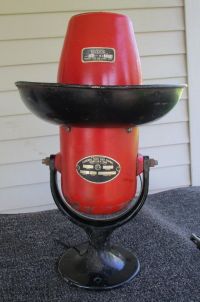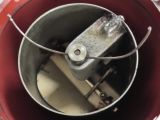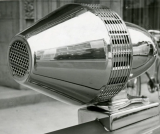Pulsator
| Pulsator | |
 A Model PL (the Pulsator-equipped version of the Model L). | |
| Company | |
|---|---|
| Produced | 1961-1980s |
| Type | Siren accessory |
The Pulsator (not to be confused with the Pulsator lights that Federal Signal currently produces) is a modification that was available for a variety of small sirens built by Federal Sign & Signal, such as the Model L, Model D, and various Federal vehicular sirens such as the Q-Siren, Model 66G, and others. It utilizes a mechanical flapper that is operated rapidly by the siren's rotor, which creates a rapid pulsed sound out of the siren as the air intake is repeatedly interrupted.
History

The Pulsator was first made available during the Federal Sign & Signal era and was introduced as early as 1961. The Pulsator itself is not a siren, rather it is an attachment that can be added to several of FS&S's small sirens by replacing the original intake with it. Sirens that are equipped with Pulsators typically have the "P" prefix, as well as an additional "0" at the end. For example, a Model 28 with a Pulsator became a Model P-280, and a Model 66G became a Model P-660 with a Pulsator. Small industrial sirens, such as the Model L, lacked the 0 at the end but included the "P" prefix.
The Pulsator was likely intended to create a significantly more distinctive and attention-grabbing signal than the standard models and was designed for use on vehicular sirens used in areas where ambient noise was significant enough to drown out normal sirens. It found popular use in many large urban cities, where it could be commonly found on police vehicles. The NYPD was particularly fond of the Pulsator, with most of its fleet in the 1960s and 1970s being equipped with sirens with P-280 Pulsators until they were replaced with electronic sirens for being too loud.
The Pulsator was discontinued somewhere in the 1980s, with it being known to have been produced as late as 1981. The advent of electronic vehicular sirens by that time had rendered the Pulsator obsolete, and most were quickly retired from service. In addition, the mechanism proved to be very fragile, with many breaking early in service. As a result it is a relatively rare sight today, although several still find their way into the hands of enthusiasts and collectors. It is unknown how many remain in active service, but a few abandoned units are still known to sit in place. Many surviving units are missing the mechanism entirely or are missing the wires that drive it.
Design


The Pulsator is very simple in design. All Pulsator-compatible sirens have four small holes on the rotor, where two metal wires on the Pulsator are threaded through. This allows the rotor to drive the Pulsator directly. When the rotor spins, the two wires spin with it, and the rotational force is sent through a small gear reduction drive above it, which then opens and closes the flapper in the intake, repeatedly allowing and blocking air from being taken in into the rotor, and creating a rapid pulse signal whose speed is entirely dependent on the speed of the rotor.
The Pulsator's mechanism is housed inside of a specialized intake, which is slightly rounded and thins out near the end. The air is only taken in through a cylindrical metal tube where the flapper and mechanism are, with the rest of the intake merely being shaped to fit the width of the stator to allow it to be screwed into it. The end of the intake has a metal mesh screen to keep debris out of the flapper, and the tube is held into the intake by 4 screws on the front.
There are multiple known models of Pulsator, including the Model P1R and P2C. The distinction between the models is currently unknown, but the mechanisms appear to be identical in all models. It may simply be a difference in the outer shell that attaches to the siren.
Due to the fragility of the wires, the Pulsator must be handled delicately and maintained well, or else the mechanism will break and be rendered useless. The other main issue with the Pulsator was its gearbox, which came with a limited supply of lubrication and would eventually dry out. This would cause friction that would prevent the Pulsator from spinning as fast as the siren's rotor, which would twist and break the thin metal wires. The Pulsators were also prone to freezing in the winter, which could also destroy the wires if the siren started while the Pulsator was frozen. NYPD cops were known for beating the sirens with their nightsticks (batons) to unfreeze the mechanism before operating the siren in the winter. As a result, many surviving ex-NYPD Pulsators have visible dents on the housing.